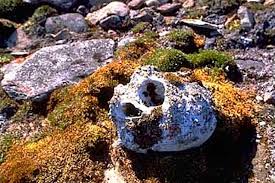 Since 2007, sixteen shoes containing severed human feet have washed up on the shores near the mouth of British Columbia’s Fraser River which supplies freshwater to the tidal Pacific Ocean at the Canadian Strait of Georgia and Washington State’s Puget Sound. Curiously, the majority of the found flotsam-footwear are large, men’s runners holding a disarticulated right foot.
Since 2007, sixteen shoes containing severed human feet have washed up on the shores near the mouth of British Columbia’s Fraser River which supplies freshwater to the tidal Pacific Ocean at the Canadian Strait of Georgia and Washington State’s Puget Sound. Curiously, the majority of the found flotsam-footwear are large, men’s runners holding a disarticulated right foot.
The story quickly gained international attention and refuses to go away. Just last month (February 2016) two more New Balance sneakers with their feet ran aground at Botanical Beach on Vancouver Island. Public speculation has stepped-up—not surprisingly given that, historically, the Pacific Northwest has the largest number of prolific serial killers per capita in the world.
 The Northwest Noir is home to Ted Bundy—the College Dorm Slayer, Gary Ridgway—the Green River Killer, Robert Pickton—the notorious Pig Farmer, Clifford Olson—the Beast of BC, Harvey Carignan—the Want-Ad Murderer, Robert Silveria—the Box-Car Killer, Gilbert Jordan—the Boozing Barber, and at least one currently active serial killer who’s terrorizing the Highway of Tears.
The Northwest Noir is home to Ted Bundy—the College Dorm Slayer, Gary Ridgway—the Green River Killer, Robert Pickton—the notorious Pig Farmer, Clifford Olson—the Beast of BC, Harvey Carignan—the Want-Ad Murderer, Robert Silveria—the Box-Car Killer, Gilbert Jordan—the Boozing Barber, and at least one currently active serial killer who’s terrorizing the Highway of Tears.
Could it be there’s another homicidal maniac on the loose—one with a fiendish foot-fetish? Someone who’s cutting off his victim’s feet and chucking them in the ocean? Possibly the Reebok Ripper at work?
Or is it more likely just as the authorities say—all the feet belong to suicide victims—jumpers from any one of more than thirty-two bridges in the Vancouver area?
 Looking at the case facts that are readily available from the police and coroner websites, ten of the feet have been identified through DNA to individuals who were suspected of taking their own life. Six of the shoes belonged to three different people and eleven of the sixteen feet detached themselves from the right leg at the ankle.
Looking at the case facts that are readily available from the police and coroner websites, ten of the feet have been identified through DNA to individuals who were suspected of taking their own life. Six of the shoes belonged to three different people and eleven of the sixteen feet detached themselves from the right leg at the ankle.
The police and coroner departments are clear there are no striation marks on the bones to suggest any mechanical manipulation by way of severing the feet with a knife, ax, or saw. The forensic specialists assure the appendages appear entirely consistent with disarticulating, or pulling away, from a body that’s been submerged in water and undergoing a natural decomposition process that’s slowed due to the cold waters of the Fraser and the Pacific.
Nothing to see here, folks, they say.
Well, hang on a minute. I’m a curious old cop and coroner. This flotsam-foot thing is something you don’t see every day. Why is this foot phenomenon unique to the region? Why did it recently start to occur? And why are so many feet from the right? I decided to tread into this with an open mind—and the help of acquaintances from my forensic days.
Foot Distribution Map
Dr. Gail Anderson is the Professor of Entomology at Vancouver’s Simon Fraser University. She pioneered a project to study decomposing pig carcasses 300 feet under the nearby Pacific and monitors the process via remote cameras to her laptop. She’s found that an entire adult hog can be left skeletonized within three weeks—being devoured by crabs, shrimp, and sea worms—as well as breaking down through a microbial process.
 But, Gail says, getting at meat wrapped up in a rubber running shoe is a whole different challenge. And floating upside down on the ocean’s surface would prevent seabirds like gulls from attacking the foot from above.
But, Gail says, getting at meat wrapped up in a rubber running shoe is a whole different challenge. And floating upside down on the ocean’s surface would prevent seabirds like gulls from attacking the foot from above.
Bill Inkster is a former dentist who now manages the identification unit for the B.C. Coroners Service. He takes the disarticulation and floatation process a step further.
“They’re not severed, they’re disarticulated,” Bill explains. “As the body decomposes, the feet are separated from the rest of the body. Time was, the feet would have stayed underwater with the rest of the body. But Nike Air, and all the other high-buoyancy sneakers that followed, changed that with designs that featured little air pockets. These floating feet are enclosed in their own PFD’s (personal floatation devices) and just bob to the surface once freed.”
 A little internet research into running shoe technology confirms that by 2005 the footwear industry profoundly changed materials in their products. Where the lightweight designs were first developed for the high-priced athletic market, the chemical advancement of switching from polyurethane (PU) mid-soles to ethylene-vinyl acetate (EVA) closed-cell blowing agents not only reduced the weight but drastically reduced manufacturing and shipping costs.
A little internet research into running shoe technology confirms that by 2005 the footwear industry profoundly changed materials in their products. Where the lightweight designs were first developed for the high-priced athletic market, the chemical advancement of switching from polyurethane (PU) mid-soles to ethylene-vinyl acetate (EVA) closed-cell blowing agents not only reduced the weight but drastically reduced manufacturing and shipping costs.
This allowed third-world makers of Nike, Adidas, New Balance, Reebok, Brooks, and other major sporting-shoe players to supply discount retailers like Walmart with cheap, yet decent runners.
 Richard Thompson is a physical oceanographer with Vancouver Island’s Institute of Ocean Sciences. He shed light on why this was happening in the Fraser River region. Thompson explained the Fraser is a heavily-mudded waterway that carries silt from the province’s interior and deposits it in a vast delta extending miles out into the Pacific. The ever expanding bridge construction along the lower Fraser has created a series of dams due to their pilings that require continual dredging to maintain the shipping lanes.
Richard Thompson is a physical oceanographer with Vancouver Island’s Institute of Ocean Sciences. He shed light on why this was happening in the Fraser River region. Thompson explained the Fraser is a heavily-mudded waterway that carries silt from the province’s interior and deposits it in a vast delta extending miles out into the Pacific. The ever expanding bridge construction along the lower Fraser has created a series of dams due to their pilings that require continual dredging to maintain the shipping lanes.
It follows that victims who jump from one bridge may be carried along the bottom—pushed down by the weight of the silt—and become lodged in another piling dam. Dredging then shakes the body which has now decomposed to the point where the feet easily detach at the ankle and the high-buoyancy shoes sneak themselves to the surface where they drift on out to sea.
 Once the shoe-encased foot meets the tidal water, it enters what Thompson describes as a giant, endless spin cycle created by the freshwater outflow, the incoming currents, twice-daily tide action and, of course, the wind. The combination of these recirculation actions results in the wide—seemingly random—distribution of where the floating feet eventually beach themselves.
Once the shoe-encased foot meets the tidal water, it enters what Thompson describes as a giant, endless spin cycle created by the freshwater outflow, the incoming currents, twice-daily tide action and, of course, the wind. The combination of these recirculation actions results in the wide—seemingly random—distribution of where the floating feet eventually beach themselves.
Once I objectively listened to the experts explaining the science behind decomposition, dredging, disarticulation and distribution of the sixteen severed feet, it made sense to me—except for one troubling fact.
Why are nearly three-quarters of the recovered runner-wraps from the right?
 I got the answer from Professor Curtis Ebbesmeyer. He’s known as the rubber-duck man and the co-author of the fascinating book Flotsametrics and the Floating World: How One Man’s Obsession with Runaway Sneakers and Rubber Ducks Revolutionized Ocean Science. Ebbesmeyer spent his lifetime studying ocean currents, including the aftermath of a shipping accident involving thousands of Nike runners being discharged into the Pacific during a storm. The resulting locations where the shoes hit land was a landmark breakthrough in a better understanding of ocean drift.
I got the answer from Professor Curtis Ebbesmeyer. He’s known as the rubber-duck man and the co-author of the fascinating book Flotsametrics and the Floating World: How One Man’s Obsession with Runaway Sneakers and Rubber Ducks Revolutionized Ocean Science. Ebbesmeyer spent his lifetime studying ocean currents, including the aftermath of a shipping accident involving thousands of Nike runners being discharged into the Pacific during a storm. The resulting locations where the shoes hit land was a landmark breakthrough in a better understanding of ocean drift.
So if anyone knows how a sneaker sneaks about in the water, it’s Professor Ebbesmeyer.
He says that left and right shoes behave differently due to their curvature—lefts tend to drift in a clockwise pattern and rights will turn counter-clockwise. This contributes to a distribution pattern where the rights went to the closest land and the lefts possibly headed for the open ocean or perhaps to more deserted beaches.
 Ebbesmeyer also pointed out an interesting and apparently verified fact—whether or not it bears weight on the floating feet. With ninety percent of the population being right-handed, most people tend to tie their right shoe tighter than the left and most people’s right foot is slightly larger than their left.
Ebbesmeyer also pointed out an interesting and apparently verified fact—whether or not it bears weight on the floating feet. With ninety percent of the population being right-handed, most people tend to tie their right shoe tighter than the left and most people’s right foot is slightly larger than their left.
With maybe more slack in a left shoe, it’s possible more of the disarticulated left flesh and bone matter would fall out of its runner, then its shoe would go to a beach empty-handed and be ignored.
There’s one last factor in these recently-found, sixteen feet and that’s the Vicious Cycle effect. The floating-foot story is so widely known throughout the Pacific Northwest that by now nobody walks by a shoe on the shoreline without picking it up and checking inside.




























